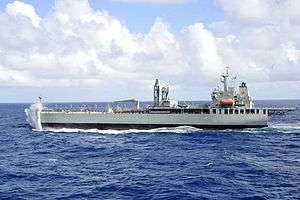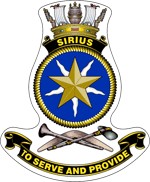HMAS Sirius (O 266)
HMAS Sirius (O 266) (formerly MT Delos) is a commercial tanker purchased by the Royal Australian Navy and converted into a fleet replenishment vessel to replace HMAS Westralia. She is named in honor of HMS Sirius of the First Fleet. Launched in South Korea on 2004, and converted in Western Australia, Sirius was commissioned in 2006; three years before a purpose-built vessel would have been built, and at half the cost. The tanker is expected to remain in service until the 2020s.
 HMAS Sirius in July 2013 | |
| History | |
|---|---|
| Name: | Sirius |
| Namesake: | Flagship HMS Sirius of the First Fleet |
| Builder: | Hyundai Mipo Dockyard |
| Launched: | 12 April 2004 |
| Acquired: | 3 June 2004 |
| Commissioned: | 16 September 2006 |
| Renamed: | MT Delos (during construction) |
| Identification: |
|
| Motto: | To Serve and Provide |
| Status: | Active as of 2019 |
| Badge: |
 |
| General characteristics | |
| Type: | Fleet Replenishment Vessel |
| Displacement: | 46,755 tonnes (full load) |
| Length: | 191.3 metres (628 ft) |
| Beam: | 32 m (105 ft) |
| Draught: | 11 m (36 ft) |
| Propulsion: | 1 × Hyundai B&W6S50MC, 1 × shaft |
| Speed: | 16.5 knots (30.6 km/h; 19.0 mph) |
| Range: | 16,000 nautical miles (30,000 km; 18,000 mi) at 14 knots (26 km/h; 16 mph) |
| Capacity: |
|
| Complement: | 8 officers, 46 sailors |
| Armament: | 5 x 12.7 mm machine guns |
| Aviation facilities: | Helicopter deck, no hangar facilities |
Construction and acquisition
Delos was built at Hyundai Mipo Dockyard in South Korea.[1] Another five ships were built to the same design, all for civilian service.[2] She was launched on 12 April 2004, and was purchased by the Australian Government on 3 June 2004 and handed over from Hyundai on 16 June 2004, with the intention of modifying her as a replacement for HMAS Westralia.[1][3][4] Delos was leased (bareboat charter) to Teekay Shipping for operation as an commercial oil tanker until September 2005, then was taken up by Tenix Defence (which had been awarded the A$60 million conversion contract on 15 March 2005) for conversion into a replenishment vessel, which was completed 5 weeks ahead of schedule.[3][4] Sirius was commissioned into the RAN on 16 September 2006, in a ceremony that included Westralia's decommissioning.[5] While HMAS Sirius is the first ship of this name to serve as part of the RAN, she is named after HMS Sirius, the flagship of the First Fleet of British convicts sent to Australia in 1788.[1]
Sirius has a full load displacement of 46,775 tonnes, is 191.3 metres (628 ft) in length, with a beam of 32 metres (105 ft) and a draught of 11 metres (36 ft).[1] Propulsion machinery consists of a single propeller shaft driven by a single Hyundai B&W 6S 50MC diesel, supplemented by a bow thruster.[3] Top speed is 16.5 knots (30.6 km/h; 19.0 mph), and the ship has a range of 16,000 nautical miles (30,000 km; 18,000 mi) at 14 knots (26 km/h; 16 mph).[3] Sirius can carry up to 34,806 cubic metres (1,229,200 cu ft) of fuel, including 5,486 cubic metres (193,700 cu ft) of helicopter aviation fuel, plus 240 tonnes of dry stores carried in a container deck designed for twelve 20-foot (6.1 m) intermodal containers.[1][3][4] Modifications by Tenix included the fitting of two replenishment points (one on each side, allowing the underway replenishment of two ships simultaneously), installation of a helicopter deck aft of the superstructure, fitting of the container deck, addition of two 70-man lifeboats and two RHIBs (the latter sourced from Westralia), and modification of the internal layout and equipment to bring it to naval standards.[1][4] Sirius is armed with five 12.7 mm machine guns for self-defence.[1] The ship's company includes 8 officers and 46 sailors.[3]
Originally, the RAN planned to have a ship specially constructed for the role.[6] The decision to instead purchase an under-construction civilian tanker and modify her for military service allowed Sirius to enter service three years before originally planned, at half the acquisition project's planned cost.[6]
Operational history

On the morning of 13 March 2009, Sirius was one of seventeen warships involved in a ceremonial fleet entry and fleet review in Sydney Harbour, the largest collection of RAN ships since the Australian Bicentenary in 1988.[7] Sirius did not participate in the fleet entry, but was anchored in the harbour for the review.
In 2010, Sirius was approved to carry and deploy boarding parties.[2] This capability was tested during Exercise Kakadu 10, along with the ship's first ever dual replenishment.[2]
Sirius was forced to turn back en route to the RIMPAC 2010 exercise in Hawaii due to problems with her engine, and did not participate in the exercise as a result.[8]
The tanker completed a six-month maintenance period in Sydney on 16 September 2014; she spent five months of this period out of the water in the Captain Cook Graving Dock.[9]
HMAS Sirius joined HMAS Stuart, KDB Darulehsan, USS Rafael Peralta and RSS Supreme on their way to Pearl Harbor, Hawaii in preparation for RIMPAC 2020 on 6 August. RIMPAC 2020 will scheduled to start on 17 August.[10]
End of service
Sirius was originally expected to remain in service for approximately 15 years.[2] In 2012, the ship was predicted to remain in service until the early 2020s.[11] The 2013 Defence White Paper stated that the replacement of Sirius and HMAS Success would be brought forward.[12] As well as building replacement vessels (either in Australia, overseas, or a combination), leasing existing vessels was also to be considered.[12]
In June 2014, the Minister for Defence announced that two companies had been invited to a restricted tender competition.[13] Spanish shipbuilder Navantia is offering the Cantabria design, while South Korea's DSME is proposing the downsized Aegir variant of the Tide-class tanker.[13][14] The 20,000+ tonne ships will be built overseas, as they will be too large to build in Australian shipyards.[13] Australia considered the design for their replacement tankers, with Navantia competing against the Aegir variant of the Tide-class tanker built by South Korea's DSME in a restricted tender competition. Navantia's proposal based on Cantabria was announced as the successful design in the Australian tender in March 2016, with an expected in service date for the first of two Supply-class replenishment oilers late 2020. [15] The effects of COVID-19 on the Spanish workforce has delayed the delivery of the first vessel (HMAS Supply) and may extend the period of service into late 2021.
See also
- MV Asterix - commercial container vessel converted to replenishing ship for Royal Canadian Navy
References
- "HMAS Sirius". Royal Australian Navy. Retrieved 3 August 2014.
- Gillett, Australia's Navy, Part 2, p. 50
- Saunders (ed.), IHS Jane's Fighting Ships 2012–2013, p. 35
- "Sirius delivered five weeks early" (PDF). The Navy. Navy League of Australia. 68 (4): 18. October 2006. Retrieved 3 August 2014.
- "Hatch, Match & Dispatch" (PDF). The Navy. Navy League of Australia. 69 (1). January 2007. Retrieved 3 August 2014.
- Australian Associated Press (26 February 2008). "Defence told to find millions in savings". Archived from the original on 28 February 2008. Retrieved 27 February 2008.
- Brooke, Michael (2 April 2009). "Marching into History". Navy News. Department of Defence.
- Dodd, Mark (6 August 2010). "No-show by subs slammed". The Australian. Retrieved 14 August 2010.
- Taylor, Mark (25 September 2014). "Battle Tanker makes a birthday splash". Navy Daily. Royal Australian Navy. Retrieved 27 September 2014.
- Milne, Sandy; Milne, Sandy (5 August 2020). "RAN commences exercises with warships from Singapore, Brunei". www.defenceconnect.com.au. Retrieved 7 August 2020.
- Gillett, Australia's Navy, Part 2, p. 51
- Department of Defence (3 May 2013). Defence White Paper 2013. Commonwealth of Australia. p. 123. ISBN 978-0-9874958-0-8.
- "Minister for Defence – Transcript – Naval shipbuilding announcement, CEA Technologies, Canberra" (Transcript). Department of Defence Ministers. 6 June 2014. Archived from the original on 22 February 2015. Retrieved 1 January 2015.
- Hewett, Jennifer (26 April 2015). "Australian ships, Australian jobs". The Australian Financial Review. Retrieved 4 May 2015.
- Saunders, Stephen; Philpott, Tom, eds. (7 August 2015). IHS Jane's Fighting Ships 2015–2016. Jane's Fighting Ships (116th Revised ed.). Coulsdon: IHS Jane's. p. 35. ISBN 9780710631435. OCLC 919022075.
- Gillett, Ross (2012). Australia's Navy: Today and Tomorrow. Part 2. Topmill. p. 50.
- Saunders, Stephen, ed. (2012). IHS Jane's Fighting Ships 2012–2013. Jane's Fighting Ships. Coulsdon: IHS Jane's. ISBN 9780710630087. OCLC 793688752.
External links
| Wikimedia Commons has media related to IMO 9283772. |
- Defence Materiel Organisation Maritime Operations Support Capability
- Australian National Audit Office Purchase, Chartering and Modification of the New Fleet Oiler